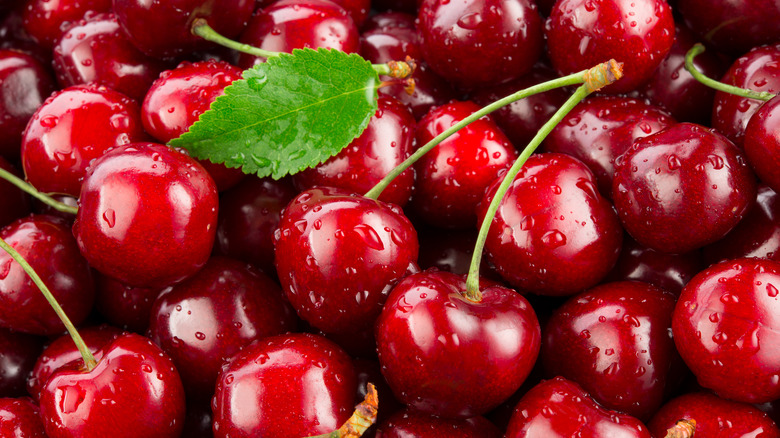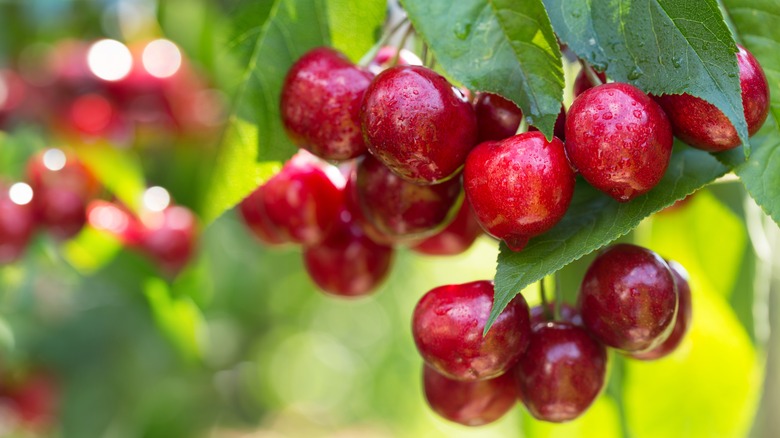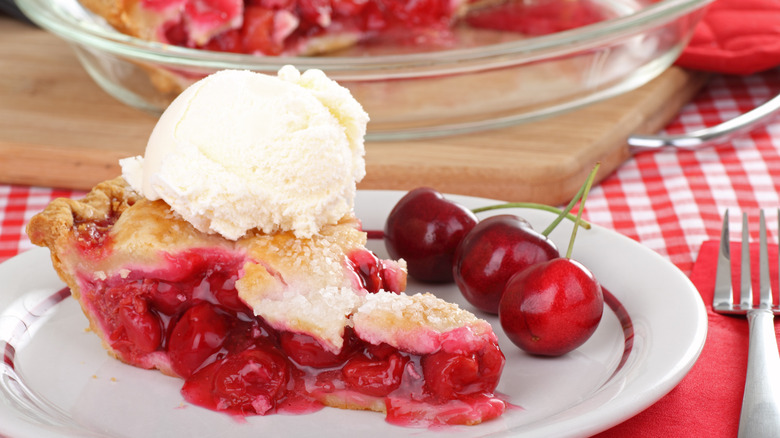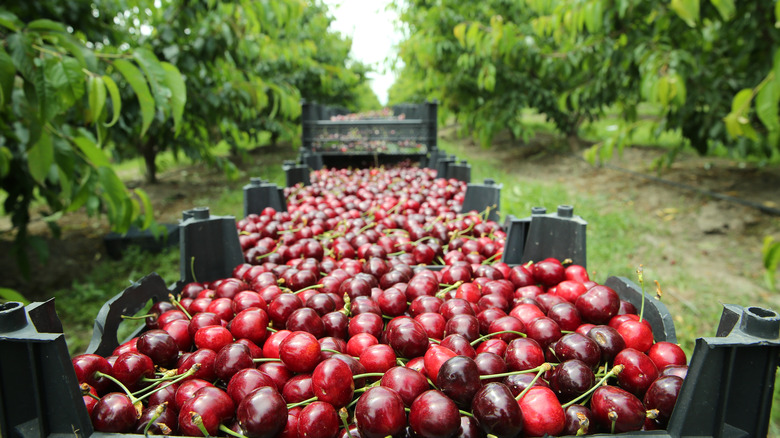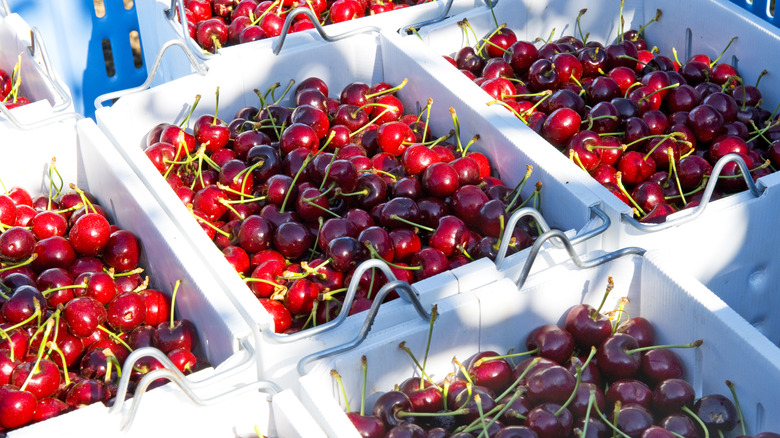What Makes Tasmanian Cherries Top Of The Line
We love eating cherries in cherry cheesecake, cherry pie, and of course, on their own right off the stem. And since cherries, along with other stone fruits, are in season during the summer, eating these little red gems is typically accompanied by a fun day in the sun. California cherries have a particularly short growing season, from the middle of May to the middle of June, so it's crucial to enjoy them while you can.
If you're looking to get your cherry fix in the middle of winter, however, one variety is in season from December to February. So why don't we usually find cherries at farmer's markets during the winter? This special type comes from Tasmania, an island state of Australia — so while they're in season during our winter, those months are part of the summertime down under. Beloved for their size, flavor, and nutritional value, Tasmanian cherries are considered to be the crème de la crème of cherries and are called the Hermès of the fruit world. So if you ever come across these gems, don't pass up an opportunity to try Tasmanian cherries — you may not even have to travel across the world to get some.
What are Tasmanian cherries?
Tasmanian cherries are considered to be some of the world's tastiest cherries, and there are a few key reasons why. Not only are they crunchy and juicy with a smaller pit (meaning each one has more cherry flesh), but they're larger than many other cherry varieties, with the largest growing up to almost 1 1/2 inches. In comparison, most cherry varieties are one inch in diameter on average. Tasmanian cherries range from dark red to reddish-brown when they're ripe.
So how do they get to be so uniquely delicious? The Tasmanian climate is ideal for cherry growing, and these fruits get to soak up the warm sun and the ocean air, spending longer on the tree than most other cherries. Tasmania also is a prime location for produce because it's mostly pest and disease free due to strict quarantine regulations, so farmers get the benefit of using fewer pesticides.
Tasmanian cherries are known by a variety of other names, including Reid fruits, Bing cherries, and sweet black cherries – although here in the U.S., you'll most likely see them called Tasmanian cherries. Their scientific name is Prunus avium, and they belong to the Prunus genus, making them a close relative of other stone fruits like peaches, plums, and apricots.
What do Tasmanian cherries taste like?
Tasmanian cherries are truly the cream of the cherry crop — if you manage to get your hands on some, you're in for a real treat. These cherries are sweet and juicy but also have a robust flavor from the long amount of time they spend ripening on cherry trees in the oceanic Tasmanian climate. Their sugary taste translates into a sweet aroma, and the flesh inside yields a satisfying crunch once you pop one in your mouth.
Much of the premier taste of Tasmanian cherries can be credited to the pristine conditions in which they're grown. Not only is the island known for being relatively pest and disease-free for fruit, but Tasmanian cherries are typically packaged in top-of-the-line materials. After they're picked, the cherries are hydro-cooled and placed in specialist cherry grading equipment that is designed to meet export regulations. At Birchs Bay Cherry orchards in Tasmania, for example, farmers never use chemical fumigation, pesticides, ripeners, or preservatives — growing conditions like those and an island climate can't help but produce delicious fruit.
How to cook with Tasmanian cherries
If you want to enjoy all a Tasmanian cherry has to offer, there's no better way than eating it by itself right off the stem. But if you'd like to get a little creative with these crimson fruits, there are plenty of ways to incorporate them into sweet and savory dishes. The easiest way, however, is to use Tasmanian cherries in any recipe that calls for sweet cherries — think cherry pie, cobbler, galette, and crumble. Texture-wise, you can substitute Tasmanian cherries in sour cherry recipes as well, although the flavor will, of course, be different. You can also try making them into jam, jelly, or sauce by removing the pits and either cooking them on the stove or pureeing them in a blender until they turn into liquid.
But the options don't end there. Cherries and chocolate notoriously pair well together, so why not try making chocolate cherry cookies or Black Forest cake, trifle, or smoothies with these Tasmanian fruits? Or try your hand at lesser-known cherry desserts and whip up Tasmanian cherry syrup, ice cream, or clafoutis. And sweet recipes aren't all these juicy fruits are good for — they also work well on a cheese board, as an ingredient in cherry salsa for chicken or fish, or as a sweet element in an otherwise savory chicken salad.
Where to buy Tasmanian cherries
If you live in Australia — Tasmania in particular — you should have no trouble finding these delicious cherries. They're typically in season from December to February, so they'll be the most plentiful during that time at grocery stores, farmer's markets, and orchards down under. People who live in China may regularly see these fruits as well, as Tasmanian cherries are often shipped to the nearby country and are particularly popular in Hong Kong.
But what about those of us here in the U.S.? West Coasters are the most likely to get their hands on these cherries, as they're most commonly shipped to southern California a few months out of the year. In fact, you may see them at big-name grocery stores like Vons, Safeway, and Pavilions in select southern California cities, such as San Diego.
Beyond California, however, it may be pretty tough to track down Tasmanian cherries. You may be able to ship them from Tasmania if you're really determined and not afraid to spend a little — a box from Glendevie Orchards in Waterloo, Tasmania, for example, will cost you $70. Many orchards, like Somercotes, only ship wholesale cherries in large quantities that may be too much for the average consumer.
Nutritional information about Tasmanian cherries
Tasmanian cherries may pack a sweet punch, but they're an overall highly nutritious food. According to Sin Kian Choon Trading, these little red fruits are rich in vitamins C, A, B3, and K and contain plenty of potassium, calcium, protein, and iron. All those vitamins and minerals are packed into a low-calorie food — according to the U.S. Department of Agriculture, one cup of cherries (with pits) only has about 87 calories. You will get almost 18 grams of sugar from a cup of cherries, but don't let that deter you — as long as you're not consuming crazy amounts of them, the fruits have actually been linked to healthy glucose regulation, Healthline shares.
There are also a plethora of health benefits that come from eating cherries. According to VeryWellFit, cherries have been associated with treatment for arthritis and gout since the 1950s, and the fruits may lower cancer risk, aid memory function, and support heart health. Make sure to stay away from chewing on the pits, however, as they contain the poisonous chemical cyanide. And if you have IBS, you may, unfortunately, want to stay away from cherries, as tasty as they may be — along with plums, nectarines, and apples, Medical News Today listed cherries as some of the highest-FODMAP fruits that can lead to cramps and constipation.
Other varieties of Tasmanian cherries
There are quite a few different varieties of Tasmanian cherries, although the most popular ones are Simone, Sweetheart, Sylvia, Regina, and Kordia cherries. Additional, less-common varieties include Sunburst, Stella, Merchant, and Summit cherries. While they vary slightly, they're all grown in Tasmania's beautiful island weather (with some growing in mainland Australia as well) and are big, sweet, and juicy.
The distinctions between the different Tasmanian cherry types come down to subtle differences in flavor, texture, color, and growing process. For instance, Stella cherries are big and bright red, have a slight tang to them, and can split under damp conditions. Meanwhile, the Sylvia and Regina varieties are darker and don't split easily, but Sylvias are much sweeter than Reginas. While these types can typically be found all throughout the wintertime (summertime to the Australians) Tasmanian cherry season, certain types are associated with seasonal holidays. The white-fleshed Vegas and bright red Vans, for instance, are usually enjoyed around Christmas, and Tasmanian cherries are often a key part of Lunar New Year celebrations in China.
